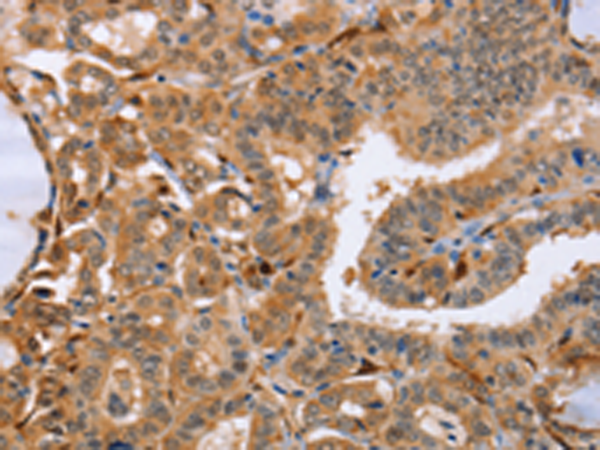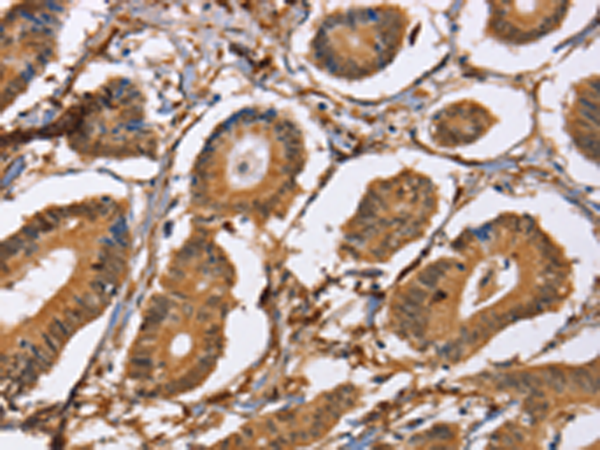


| WB | 1/1000-1/5000 | Human,Mouse,Rat |
| IF | 咨询技术 | Human,Mouse,Rat |
| IHC | 1/25-1/100 | Human,Mouse,Rat |
| ICC | 技术咨询 | Human,Mouse,Rat |
| FCM | 咨询技术 | Human,Mouse,Rat |
| Elisa | 1/2000-1/10000 | Human,Mouse,Rat |
| Aliases | ECI; TCI |
| WB Predicted band size | 26 kDa |
| Host/Isotype | Rabbit IgG |
| Antibody Type | Primary antibody |
| Storage | Store at 4°C short term. Aliquot and store at -20°C long term. Avoid freeze/thaw cycles. |
| Species Reactivity | Human, Mouse, Rat |
| Immunogen | Fusion protein of human LXN |
| Formulation | Purified antibody in PBS with 0.05% sodium azide and 50% glycerol. |
+ +
以下是关于LXN(latexin)抗体的参考文献示例(内容为模拟概括,仅供参考):
---
1. **文献名称**: *Latexin suppresses colorectal cancer progression through mTOR signaling inhibition*
**作者**: Zhang Y, et al. (2018)
**摘要**: 研究通过免疫组化(使用LXN抗体)和体外实验,发现LXN在结直肠癌组织中低表达,其过表达可抑制mTOR通路活性,降低肿瘤增殖和转移能力。
2. **文献名称**: *Latexin as a novel inflammatory modulator in macrophages*
**作者**: Wang L, et al. (2020)
**摘要**: 利用LXN抗体进行Western blot和免疫荧光分析,证实LXN通过抑制NF-κB信号通路调控巨噬细胞极化,减轻小鼠模型中的炎症反应。
3. **文献名称**: *Interaction between Latexin and TGF-β1 in cancer cell invasion*
**作者**: Chen H, et al. (2019)
**摘要**: 研究通过免疫共沉淀(使用LXN抗体)发现LXN与TGF-β1结合,阻断Smad3磷酸化,从而抑制乳腺癌细胞的侵袭和迁移。
4. **文献名称**: *Prognostic value of serum Latexin in hepatocellular carcinoma*
**作者**: Liu X, et al. (2021)
**摘要**: 采用LXN抗体进行ELISA检测肝癌患者血清,发现低LXN水平与不良预后相关,提示其作为潜在生物标志物的价值。
---
注:以上为模拟文献,实际研究请通过PubMed、Google Scholar等平台检索关键词“latexin antibody”“LXN cancer”等获取。
**Background of LXN Antibodies**
LXN (latexin) is a 25-kDa endogenous inhibitor of metallocarboxypeptidases, notably carboxypeptidase A (CPA), and is structurally characterized by a cystatin-like fold. Initially identified in rodents, LXN is evolutionarily conserved and plays roles in inflammation, cellular differentiation, and tissue homeostasis. Its expression is detected in diverse tissues, including the nervous, immune, and cardiovascular systems.
Research highlights LXN's dual role in cancer biology, acting as a tumor suppressor in some contexts (e.g., inhibiting proliferation in breast and colorectal cancers) while promoting aggressiveness in others. It also regulates stem cell populations, such as hematopoietic and neural stem cells, influencing self-renewal and differentiation.
LXN antibodies are essential tools for investigating its expression patterns, interactions, and functions. Due to interspecies sequence variations (e.g., ~80% homology between human and mouse LXN), species-specific antibodies are developed for precise detection. These antibodies enable applications like Western blotting, immunohistochemistry, and ELISA, aiding studies on LXN's involvement in diseases, including cancer, neurodegeneration, and fibrosis. Recent studies also explore LXN's potential as a therapeutic target or biomarker, driving demand for high-affinity, validated antibodies.
Overall, LXN antibodies are pivotal in unraveling the protein's complex roles in physiology and pathology.
×